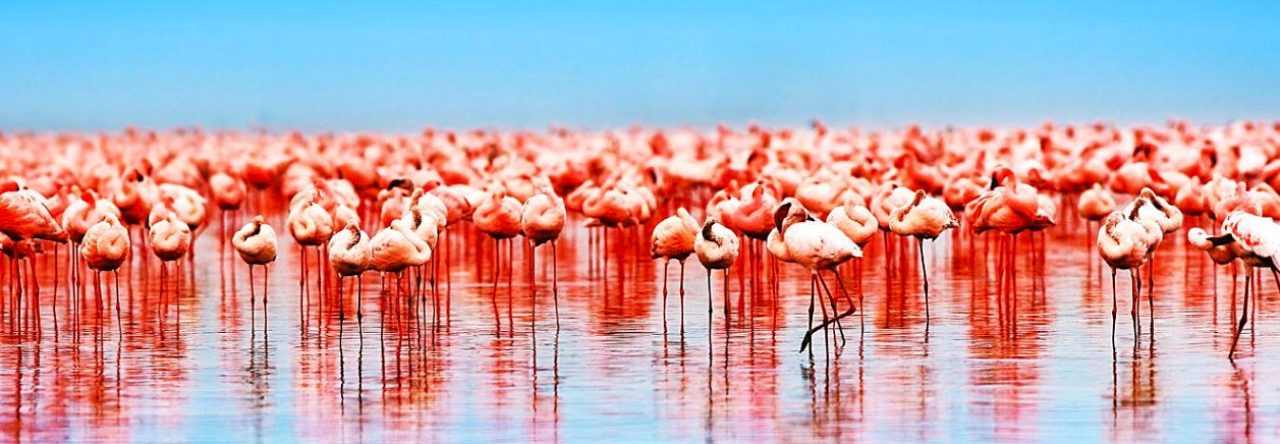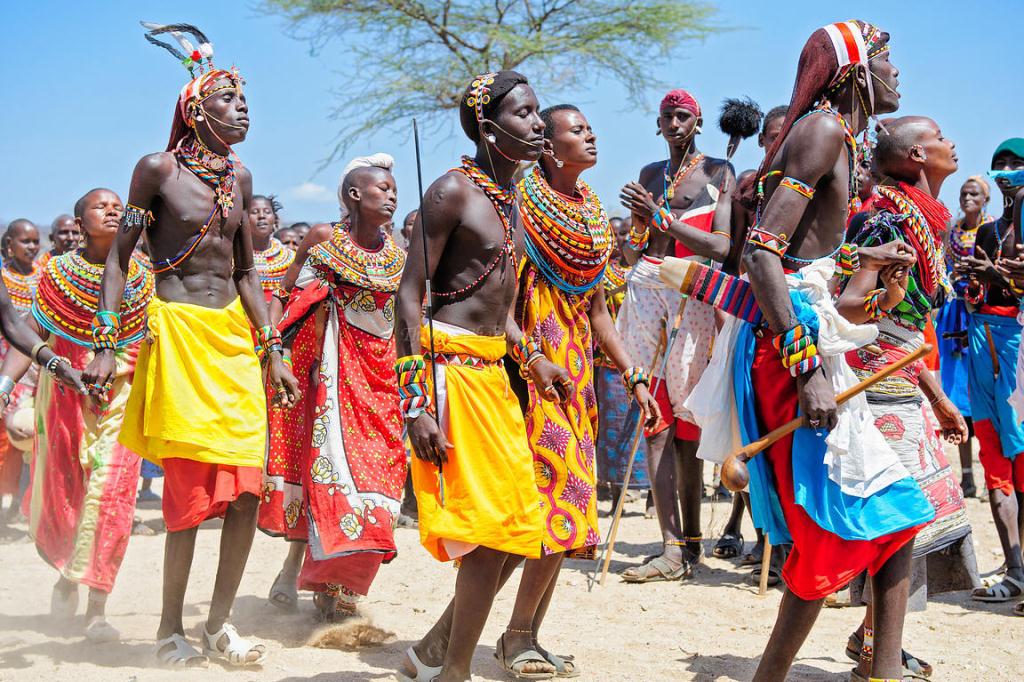The Samburu people live north of the equator and live in very diverse and beautiful landscapes that span high altitude forests, open plains, semi-arid grass and bush land to complete desert.
The Samburu developed from one of the later Nilotic migrations from the Sudan, as part of their plains Nilotic movement, moving southwards along the plains of the Rift Valley in a rapid, all-conquering advance.
The Samburu are semi-nomadic pastoralists. Cattle, as well as sheep, goats and camels, are of utmost importance to the Samburu culture and way of life. The Samburu are extremely dependent on their animals for survival. They are related to the Maasai, share a few traditions, but are overall pretty distinct from each other.
The Samburu people speak the Samburu language, which is a Nilo-Saharan language. Their language is more or less similar to Maa (the language that the Maasai speak). The Samburu tongue is also related to Turkana and Karamojong and more distantly to Pokot and the Kalenjin languages.
Traditional Samburu Culture
Despite the powerful forces of modernity, the Samburu take pride in their culture and keeping their rich traditions alive.
The tribe is strongly rooted in its culture, norms beliefs and values. They have a strong oral tradition, passing down their history and customs through stories and riddles. These fascinating tales are given to the children of the tribes around crackling fires inside the Manyattas, or under moonlit skies in the arid plains around the villages. Adding to the magic and impressing upon the minds of future generations the importance of the Samburu and respect for the land, the animals and their elders.
The Rift Valley province in Kenya is a dry, somewhat barren land, and the Samburu have to relocate to ensure their cattle can feed. Every 5-6 weeks the group will move to find fresh grazing grounds. Their huts are built from mud, hide and grass mats strung over poles. A thorny fence is built around the huts for protection from wild animals. These settlements are called manyattas . The huts are constructed so they are easily dismantled and portable when the Samburu move to a new location.
The Samburu usually live in groups of five to ten families. Traditionally men look after the cattle and they are also responsible for the safety of the tribe. As warriors they defend the tribe from attack by both man and animals. They also go on raiding parties to try and take cattle from rival Samburu clans.
Samburu boys learn to tend cattle from a young age and are also taught to hunt. An initiation ceremony to mark their entry into manhood is accompanied by circumcision. The women take care of things like building houses, collecting firewood and food from forest, cooking food, milking cows, taking care of young and in doing craftsmanship. Samburu women are in charge of gathering roots and vegetables, tending to children and collecting water. In their own terms, a Samburu woman is much more hard-working than a Samburu man.
Duties of boys and girls are clearly delineated. Boys herd cattle and goats and learn to hunt, defending the flocks.
The moran phase – the warrior stage in the life of younger (under 30) Samburu men –provides a strategic position both economically and militarily, and is still desired nowadays. Because the Samburu moran has the duty to defend the community and the livestock, the moran-hood promotes values as self-respect, perseverance, courage and fellowship, giving the young men popular attention, glamour and a sense of freedom, but also a strong sense of responsibility.
Samburu girls generally help their mothers with their domestic chores like fetch water and wood and cook. Both boys and girls go through an initiation into adulthood, which involves training in adult responsibilities and circumcision for boys and clitoridectomy for girls.
Dancing
Dancing is very important in the Samburu culture. Dances are similar to that of the Maasai with men dancing in a circle and jumping very high from a standing position. The Samburu have traditionally not used any instruments to accompany their singing and dancing. Men and women do not dance in the same circles, but they do coordinate their dances. Likewise for village meetings, men will sit in an inner circle to discuss matters and make decisions. Women sit around the outside and interject with
Living
They live in houses called Manyatta (build by women) which are of plastered mud or hides and grass mats stretched over a frame of poles.
Since the Samburus’ practice polygynous marriage, their settlements or manyattas mirror this setup. Each manyatta might have 4 or 5 families and within each family, there might be multiple wives who live in their own house. The entire manyatta is surrounded by acacia thorn bush fence to prevent the people and their cattle from predators. The cattle are again surrounded by a second layer of thorn fence in the center of each manyatta. One or two Samburu men would keep watch every night and protect the entire village.
Clothing
They wear traditional costumes of woven fabrics, animal skins, wool blankets, ochre, beads and other ornaments. Samburu traditional dress is a striking red cloth wrapped around like a skirt (called Shukkas) and a white sash, this is enhanced with many colorful beaded necklaces, earrings and bracelets. Both men and women wear jewelry although only the women make it. Both men and women wear extremely bright colours. This may be because they want to add some life to the otherwise barren landscape or to make their dark skin glow.
Men wear a cloth which is often pink or black and is wrapped around their waist in a manner, they adorn themselves with necklaces, bracelets and anklets, like the Maasai. Women wear two pieces of blue or purple cloth, one piece wrapped around the waist, the second wrapped over the chest.
The warrior men cover their head in red ochre. The elders (both men and women) are clean shaven.
It is said that the more beads or necklaces are there on a women, the more beautiful she is considered. Another point on the same line of thought is that, women were more necklaces as they get richer. Therefore, the number of beads or necklaces indicates status in society, richness level and beauty.
The Samburu also paint their faces using striking patterns to accentuate their facial features. Neighboring tribes, admiring the beauty of the Samburu people, called them samburu which in fact means “butterfly
Food and society
Milk, blood and Maize (corn) is Samburu’s main food. The blood is drawn by piercing the vein of a cow with a spear or knife, after which the wound is resealed with hot ashes. They don’t slaughter their animals very often. The Samburu tribe only eats meat on special occasions and during ceremonies such as the birth of a child, initiation and marriage.
They also make soups from roots and barks and eat vegetables if living in an area where they can be grown.
Religion & Beliefs
Traditionally, the Samburu believed in one supreme god – Nkai or Ngai – who was thought to reside in the mountains. The Samburu believe that God (Nkai) is the source of all protection from the hazards of their existence.Diviners often acted as intermediaries between other mortals and Nkai.
The elders occupy a very important place in the Samburu society and all the power rests with them. They have a polygamous system where the elders decide who can marry and have how many wives. This kind of control helps keep trouble at rest or at least that is the belief.
The Samburu calendar is important to determine the seasons, times of drought. Rituals and rains. Elders of the tribe have a mystical knowledge of these seasons and, without calendars, can determine the correct time for every activity. Certain families who have this heuristic foresight are consulted before every tribal event is planned.
“Bright bead collars, mud make-up and cow’s BLOOD for breakfast” These people will totally fascinate you.
https://www.youtube.com/watch?v=FLgfO-Ih2M8



Leave a Reply